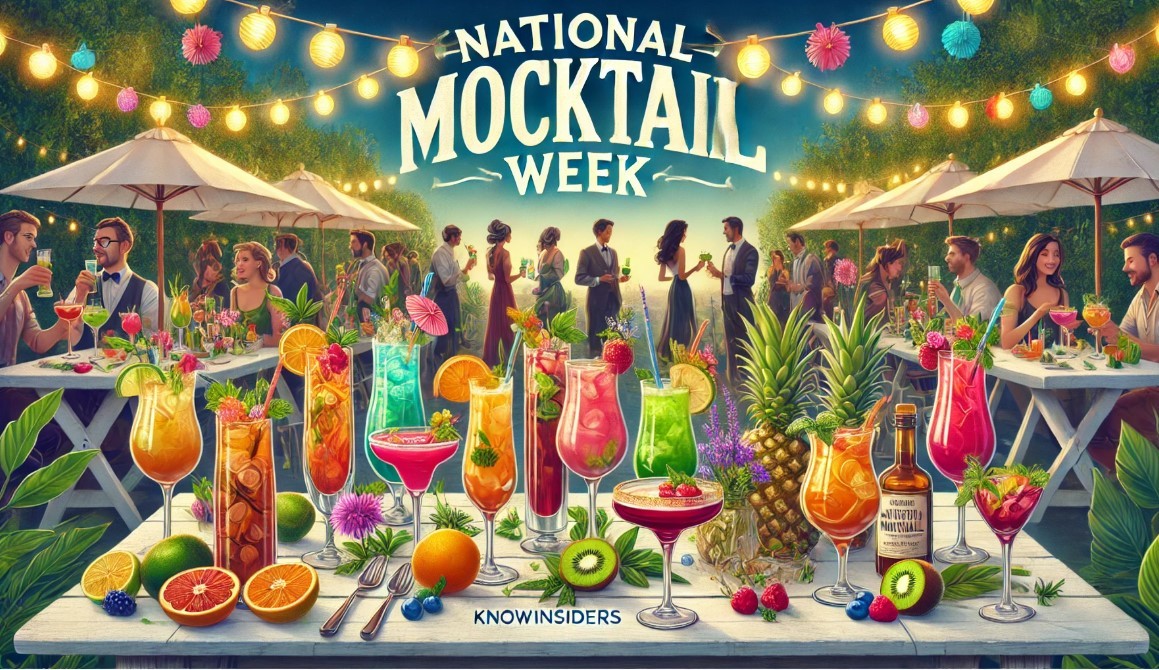St. Andrew’s Day: Origin, Significance, And Celebrations
 |
| A cozy table setup for St. Andrew’s Day, filled with traditional Scottish dishes, tartan patterns, rustic decor, and a Saltire flag centerpiece.Illustration: KnowInsiders |
St. Andrew’s Day, celebrated annually on November 30, is a day to honor St. Andrew, the patron saint of Scotland. For the Scottish people, it is a time for national pride, remembrance, and celebrating cultural heritage. St. Andrew’s Day marks the beginning of Scotland’s winter festivities, which continue through Christmas, Hogmanay (New Year’s), and Burns Night. The holiday is rich in history and traditions, with roots that intertwine religious reverence with national identity.
Who Was St. Andrew?
St. Andrew was one of Jesus Christ’s twelve apostles and the brother of St. Peter. Known for his dedication to spreading Christianity, he was a humble fisherman from Galilee who became a “fisher of men” after meeting Jesus. He traveled widely to preach the Christian gospel, eventually reaching the shores of what we know today as Greece. St. Andrew was martyred in Patras, where he chose to be crucified on an X-shaped cross, now known as the St. Andrew’s Cross or Saltire, rather than a traditional cross, as he did not feel worthy of the same cross as Jesus.
Though St. Andrew never visited Scotland, he became its patron saint due to various legends and stories that connect him to the country. One popular tale states that his relics were brought to Scotland by St. Regulus, a Greek monk who received instructions in a dream. According to this story, St. Regulus shipwrecked on the shores of Fife, and the relics were interred in what is now the town of St. Andrews.
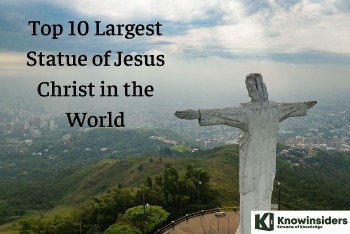 Top 10 Largest Statue of Jesus Christ in the World Top 10 Largest Statue of Jesus Christ in the World |
The Significance of St. Andrew’s Day in Scotland
St. Andrew’s Day has been celebrated in Scotland for centuries, holding deep national significance. St. Andrew was adopted as Scotland’s patron saint around the 9th century, and the Saltire, a blue flag with a white diagonal cross, was inspired by the shape of the cross on which he was crucified. The Saltire has since become a powerful national symbol, symbolizing Scotland’s resilience and distinct identity.
For many Scots, St. Andrew’s Day is a day of reflection on Scottish culture, history, and heritage. It marks a day of unity for Scottish people both in Scotland and around the world, reminding them of the strength and perseverance of their ancestors. Though it is not a public holiday throughout the United Kingdom, it is recognized as a bank holiday in Scotland, allowing more people to participate in local events and gatherings.
Historical Traditions and Legends
The traditions surrounding St. Andrew’s Day are steeped in history and legend. One of the most well-known stories involves a battle in the 9th century between the Scots and the Angles. According to legend, King Óengus II of Scotland prayed for victory, and in the morning, a cloud formation resembling the X-shaped cross of St. Andrew appeared in the sky. The Scots won the battle, and the cross became a symbol of divine protection, further cementing St. Andrew’s place as Scotland’s patron saint.
Historically, people celebrated St. Andrew’s Day by feasting, gathering for prayer, and honoring the saint through storytelling and songs. In rural Scotland, it was also seen as the start of Advent, the season leading up to Christmas, marked by reflection and spiritual preparation. Although St. Andrew’s Day was not always widely celebrated, recent decades have seen a revival, as Scots take greater pride in their cultural heritage.
How St. Andrew’s Day is Celebrated Today
Modern celebrations of St. Andrew’s Day bring together traditional practices with contemporary festivities. Scottish towns and cities host a variety of events, from ceilidhs (traditional Scottish dances) to cultural festivals and parades. Here’s a look at some of the most popular activities:
• Ceilidhs and Traditional Scottish Dancing
One of the highlights of St. Andrew’s Day is the ceilidh, a social gathering featuring traditional Scottish folk music and dancing. Many Scots and visitors attend ceilidhs on St. Andrew’s Day to join in the lively jigs and reels. Scottish dances, such as the Highland fling, Sword dance, and Strathspey, bring communities together in a spirit of joy and celebration. Traditional instruments like the fiddle, bagpipes, and accordion add to the atmosphere, creating a vibrant, communal experience.
• Festivals and Parades
Across Scotland, many cities organize St. Andrew’s Day festivals, showcasing Scottish music, storytelling, and arts. In Edinburgh, the St. Andrew’s Day Torchlight Procession is a popular event where participants carry torches through the city’s historic streets. The parade creates a magical atmosphere, symbolizing the enduring spirit of St. Andrew’s legacy.
• Feasting on Traditional Scottish Food
St. Andrew’s Day is also a time for enjoying traditional Scottish cuisine. Many people prepare a special feast, featuring haggis, neeps and tatties (turnips and potatoes), Cullen skink (a creamy fish soup), and clootie dumpling (a steamed pudding). The day is an opportunity to savor Scotland’s culinary heritage, often accompanied by whisky or Irn-Bru, Scotland’s popular soft drink. Some people also prepare a St. Andrew’s Day supper, inviting family and friends to share in the meal.
• Community Events and Charitable Activities
St. Andrew’s Day promotes kindness and community spirit, with many events dedicated to charity and local causes. Schools, churches, and community organizations often host gatherings where people can donate to food banks, support local charities, or volunteer. The day fosters a spirit of giving, inspired by St. Andrew’s reputation as a “fisher of men” who reached out to those in need.
St. Andrew’s Day Beyond Scotland
Though St. Andrew’s Day is a distinctly Scottish holiday, it is celebrated worldwide by Scottish communities and those with Scottish heritage. In countries like Canada, the United States, and Australia, Scottish societies organize events, dinners, and gatherings to honor St. Andrew and celebrate Scottish culture. These gatherings serve as a way for Scottish expatriates and their descendants to connect with their roots, share traditions, and keep their heritage alive.
The day also provides an opportunity to educate others about Scotland’s history and culture, as many people in these countries might be unfamiliar with St. Andrew’s Day. Scottish communities host performances of traditional music, dance, and poetry, providing insight into the richness of Scotland’s heritage.
Modern Recognition and Official Status
St. Andrew’s Day became an official bank holiday in Scotland in 2006, giving more Scots the chance to celebrate their patron saint. Although it is not a public holiday across the United Kingdom, Scottish schools and institutions often organize educational activities to teach students about St. Andrew and his significance in Scottish history. In schools, children learn about St. Andrew through storytelling, art projects, and history lessons. They also engage in cultural activities, such as learning Scottish songs and dances, helping to instill pride in Scottish heritage from a young age.
St. Andrew’s Cross and Its Symbolism
The Saltire, or St. Andrew’s Cross, is one of Scotland’s most recognizable symbols. This blue flag with a white diagonal cross not only represents St. Andrew’s martyrdom but also symbolizes Scotland’s pride, resilience, and distinct identity. The Saltire is prominently displayed on St. Andrew’s Day, from public buildings to private homes, uniting Scots in a shared sense of identity.
The Saltire has become a powerful symbol for Scotland, featured on everything from kilts and Scottish souvenirs to the Scottish Parliament’s official emblem. On St. Andrew’s Day, the flag takes on even more significance, serving as a reminder of Scotland’s unique place in the world.
Comparing St. Andrew’s Day to Other Scottish Celebrations
St. Andrew’s Day is part of a trilogy of Scottish winter celebrations, followed by Hogmanay and Burns Night. Hogmanay, celebrated on New Year’s Eve, is known for its grand festivities and traditions, including “first-footing” and fireworks. Burns Night, held on January 25, commemorates the life and works of Scotland’s national poet, Robert Burns, and is celebrated with Burns suppers, poetry readings, and toasts with whisky. While St. Andrew’s Day is rooted in religious and national identity, Burns Night and Hogmanay are more secular, highlighting Scotland’s literary and cultural achievements.
Each of these holidays contributes to Scotland’s unique winter season, filled with warmth, tradition, and a sense of community. Together, they embody Scotland’s spirit, offering different expressions of pride, remembrance, and joy.
Conclusion
St. Andrew’s Day stands as a symbol of Scottish pride, heritage, and community. Although St. Andrew never set foot in Scotland, his legacy has woven itself deeply into the country’s history, from the Saltire that flies proudly across the land to the values of compassion and resilience that Scots hold dear.
Celebrating St. Andrew’s Day is a way for Scots to connect with their roots, honor their past, and look forward to the future. Whether through a festive ceilidh, a family meal, or a simple moment of reflection, Scots everywhere take time on November 30 to remember the patron saint who has come to represent their nation’s soul. For those outside of Scotland, St. Andrew’s Day provides a meaningful window into the heart of Scottish culture, offering a rich tapestry of history, tradition, and celebration.
FAQs about St. Andrew’s Day
1. Who is St. Andrew, and why is he important to Scotland?
St. Andrew was one of Jesus Christ’s twelve apostles and is known as Scotland’s patron saint. Although he never visited Scotland, he became the country’s patron due to legends that his relics were brought to Scottish shores. St. Andrew is celebrated for his role in spreading Christianity and symbolizes Scottish values of compassion, humility, and resilience.
2. When is St. Andrew’s Day celebrated?
St. Andrew’s Day is celebrated on November 30 each year. This date marks the traditional feast day of St. Andrew and is a national day of celebration in Scotland.
3. Is St. Andrew’s Day a public holiday in Scotland?
Yes, since 2006, St. Andrew’s Day has been recognized as a bank holiday in Scotland, though it is not a public holiday in the rest of the United Kingdom. Some businesses and schools may close, allowing more Scots to participate in celebrations.
4. What are common traditions on St. Andrew’s Day?
Common traditions include attending ceilidhs (traditional Scottish dances), hosting family feasts, and participating in community events and parades. People also enjoy traditional Scottish foods and listen to Scottish music. Many Scottish towns organize festivals with music, dance, and storytelling.
5. What types of food are eaten on St. Andrew’s Day?
Traditional foods served on St. Andrew’s Day include haggis, neeps and tatties (turnips and potatoes), Cullen skink (a creamy fish soup), and clootie dumpling (a steamed pudding). These dishes showcase the flavors of Scottish cuisine and are often accompanied by whisky or Irn-Bru.
6. Can tourists participate in St. Andrew’s Day celebrations?
Absolutely! Tourists are welcome to join in the festivities, including ceilidhs, parades, and local events. Major cities like Edinburgh, Glasgow, and St. Andrews often host large celebrations that are open to everyone.
7. How is the Saltire flag connected to St. Andrew?
The Saltire, also known as St. Andrew’s Cross, is Scotland’s national flag, featuring a white X-shaped cross on a blue background. The design represents the diagonal cross on which St. Andrew was martyred and is a powerful symbol of Scottish identity and pride.
8. Is St. Andrew’s Day only celebrated in Scotland?
While St. Andrew’s Day is most prominently celebrated in Scotland, it is also observed by Scottish communities around the world, particularly in countries like Canada, the United States, and Australia. Scottish societies abroad often organize events, dinners, and gatherings to honor St. Andrew.
9. How does St. Andrew’s Day compare to other Scottish celebrations like Burns Night or Hogmanay?
St. Andrew’s Day is a national holiday focusing on Scotland’s patron saint, while Burns Night (January 25) celebrates Scotland’s poet Robert Burns, and Hogmanay (New Year’s Eve) marks the New Year. All three holidays highlight different aspects of Scottish culture, from religious and historical roots to literature and New Year’s traditions.
10. How did St. Andrew become Scotland’s patron saint?
According to legend, St. Andrew’s relics were brought to Scotland by St. Regulus, who was shipwrecked on the coast of Fife. Another legend tells of a battle in which the Scots saw an X-shaped cross in the sky, symbolizing St. Andrew’s protection. Since then, St. Andrew has been revered as the patron saint of Scotland.
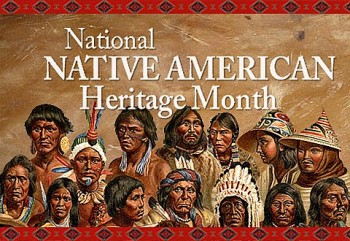 Native American Heritage Month: History, Significance, and Celebrations Native American Heritage Month: History, Significance, and Celebrations Native American Heritage Month is celebrated throughout the United States in November, recognizing the rich cultures, histories, and contributions of Native Americans. |
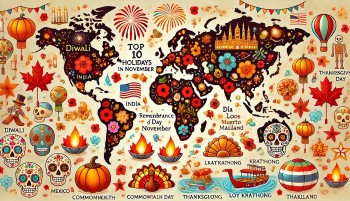 Top 10 Most Popular Holidays in November Around the World Top 10 Most Popular Holidays in November Around the World In this article, we’ll explore the top 10 most popular November holidays and festivals celebrated globally, each with its own distinct traditions and significance. |
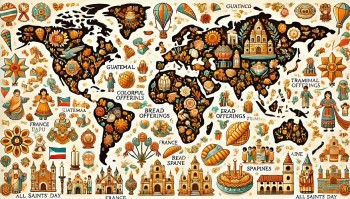 All Saints' Day - Origin, Meaning, Traditions, and Celebrations Around the World All Saints' Day - Origin, Meaning, Traditions, and Celebrations Around the World All Saints’ Day, celebrated on November 1st, is a day of solemn remembrance and gratitude across the Christian world. |
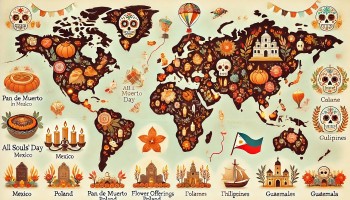 All Souls' Day - Origins, Significance, Lessons, And Traditions Around The World All Souls' Day - Origins, Significance, Lessons, And Traditions Around The World All Souls' Day, observed on November 2nd, is a sacred day in the Christian calendar dedicated to remembering and praying for the souls of the ... |



